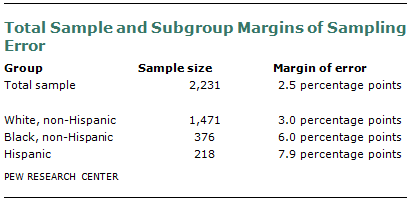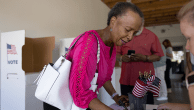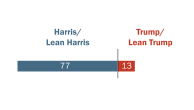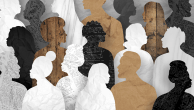The survey findings presented in this report are based on telephone interviews conducted Aug. 1-11, 2013, among a nationally representative sample of 2,231 adults living in the continental United States. Telephone interviews were conducted by landline (1,079) and cell phone (1,152, including 578 without a landline telephone). The survey was conducted in two waves: the first from Aug. 1-4, 2013, the second from Aug. 8-11, 2013. The surveys were conducted by interviewers at Princeton Data Source under the direction of Princeton Survey Research Associates International (PSRAI). A combination of landline and cell phone random digit dial samples were used; samples were provided by Survey Sampling International. Respondents in the landline sample were selected by randomly asking for the youngest adult male or female who was currently at home. Interviews in the cell sample were conducted with the person who answered the phone, if that person was an adult 18 years of age or older. In addition to this base sample, 144 interviews were conducted with African Americans by dialing recently interviewed households from PSRAI’s weekly omnibus surveys. Interviews were conducted in English and Spanish. For detailed information about our survey methodology, see: http://pewresearch.org/pewresearch-org/politics/methodology/.
A three-stage weighting procedure was used to weight this dual frame sample. The first stage of weighting corrected for different probabilities of selection associated with the number of adults in each household and each respondent’s telephone usage patterns. The second stage of weighting corrected for the oversampling of African Americans from the callback sample. The third and final stage of weighting balances the sample demographics to population parameters using an iterative technique that matches gender, age, education, race, Hispanic origin and region to parameters from the 2011 Census Bureau’s American Community Survey and population density to parameters from the Decennial Census.
The sample also is weighted to match current patterns of telephone status, based on extrapolations from the 2012 National Health Interview Survey. The weighting procedure also accounts for the fact that respondents with both landline and cell phones have a greater probability of being included in the combined sample and adjusts for household size among respondents with a landline phone. Sampling errors and statistical tests of significance take into account the effect of weighting.
The following table shows the unweighted sample sizes and the error attributable to sampling that would be expected at the 95% level of confidence for different groups in the survey:

In addition to sampling error, one should bear in mind that question wording and practical difficulties in conducting surveys can introduce error or bias into the findings of opinion polls.




